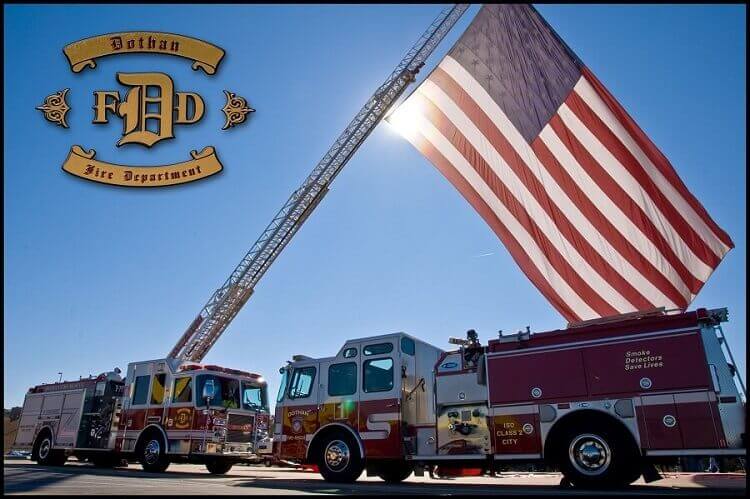
The Dothan Fire Department is committed to recruiting the best candidates our community has to offer. Candidates must possess a positive attitude, strong work ethic, and be physically fit. We offer mentorship to help prepare individuals for the Candidate Physical Ability Test (CPAT). This is a one-on-one coaching session hosted by the professionals of The Dothan Fire Department.
Date and Time :
January 10th
March 28th
May 9th
August 9th
October 24th
December 12th
Mentorship vs. Testing:
Mentorship consist of you walking through each station with a Mentor. They will go over each movement giving pointers and giving you the option to try it out.
Testing will be you being timed as you attempt to complete the course. No help will be given.
**All Testing starts at 8:00 am**
Location:
-Behind the old National Guard Armory
(Blue Building)
– Entrance is on Choctaw St.
573 Westgate Parkway

Cost:
$50.00 per candidate (payable by cash, check, or money order)
(Fees will be collected day of)
Payable to: City of Dothan
CPAT EVENT DESCRIPTIONS
Using a StepMill stair-climbing machine, this event is designed to simulate the critical task of climbing stairs in full protective clothing while carrying a high-rise pack (hose bundle) and firefighter equipment. This event challenges aerobic capacity, lower body muscular endurance and the ability to balance.
Participants wear a 12.5-pound weight on each shoulder to simulate the weight of a high-rise pack. Immediately following a 20-second warm-up period at a rate of 50 steps per minute, the timed part of the test starts as indicated by a proctor. There is no break in time between the warm-up period and the actual timing of the test. During the warm-up period, dismounting, grasping the rail, or holding the wall to establish balance and cadence is permitted. The timed part of the test lasts three (3) minutes at a stepping rate of 60 steps per minute.
Failure can occur by falling or dismounting three times during the warm-up period, or by falling or dismounting the StepMill after the timed CPAT begins. During the test, the participant is permitted to touch the wall or handrail for balance only momentarily; if that rule is violated more than twice during the test, failure will result.
This event is designed to simulate the critical tasks of dragging an uncharged hoseline from a fire apparatus to a structure and pulling an uncharged hoseline around obstacles while remaining stationary. This event challenges aerobic capacity, lower body muscular strength and endurance, upper back muscular strength and endurance, grip strength and endurance, and anaerobic endurance.
A hoseline nozzle attached to 200 feet of hose is grasped and placed over the shoulder or across the chest up to eight feet. While walking or running, the participant drags the hose 75 feet to a pre-positioned drum, makes a 90° turn, and continues an additional 25 feet. After stopping within the marked box, the candidate drops to at least one knee and pulls the hoseline until the 50-foot mark crosses the finish line.
During the hose drag, failure results if the participant does not go around the drum or goes outside of the marked path. During the hose pull, a warning is given if at least one knee is not kept in contact with the ground or if the knees go outside the marked boundary line; a second warning constitutes failure.
This event uses two saws and a tool cabinet replicating a storage cabinet on a fire truck. It is simulates the critical tasks of removing power tools from a fire apparatus, carrying them to the emergency scene, and returning the equipment to the fire apparatus. This event challenges aerobic capacity, upper body muscular strength and endurance, lower body muscular endurance, grip endurance, and balance.
The candidate must remove the two saws from the tool cabinet, one at a time, and place them on the ground. Then he/she picks up both saws (one in each hand) and carries them while walking 75 feet around a drum, then back to the starting point. Placing the saw(s) on the ground to adjust a grip is permitted. Upon return to the tool cabinet, the saws are placed on the ground, then picked up one at a time, and replaced in the cabinet.
Dropping either saw on the ground during the carry will result in immediate failure. A warning will be given for running; a second warning constitutes a failure.
This event, which uses two 24-foot aluminum extension ladders, is designed to simulate the placement of a ground ladder at a fire structure and extending it to the roof or window. This event challenges aerobic capacity, upper body muscular strength, lower body muscular strength, balance, grip strength, and anaerobic endurance. The participant must walk to the top rung of oneladder, lift the unhinged end from the ground, and walk it up hand over hand until it is stationary against the wall. Then he/she immediately proceeds to the other pre-positioned ladder, stands with both feet within the marked box, extends the fly section hand over hand until it hits the stop, then lowers it back to the starting position.
Immediate failure will result if the ladder is allowed to fall to the ground, if control is not maintained in a hand-over-hand manner, or if the rope halyard slips in an uncontrolled manner. Missing any rung during the raise or allowing one’s feet to extend outside of the boundary results in a warning; a second warning constitutes a failure.
This event uses a mechanized device that measures cumulative force and a 10-pound sledgehammer. It simulates the critical tasks of using force to open a locked door or to breach a wall. This event challenges aerobic capacity, upper body muscular strength and endurance, lower body muscular strength and endurance, balance, grip strength and endurance, and anaerobic endurance.
For this event, the candidate uses the sledgehammer to strike a measuring device in a target area until the buzzer activates. Feet must be kept outside the toe-box at all times.
Failure results if the participant does not maintain control of the sledgehammer and releases it from both hands while swinging. A warning is given for stepping inside the toe-box; a second warning constitutes a failure.
This event uses an enclosed search maze that has obstacles and narrowedspaces. It simulates the critical task of searching for a fire victim with limited visibility in an unpredictable area. This event challenges aerobic capacity, upper body muscular strength and endurance, agility, balance, anaerobic endurance, and kinesthetic awareness.
For this event, the candidate crawls through a tunnel maze that is approximately 3 feet high, 4 feet wide, 64 feet in length, and has two 90° turns and multiple obstacles. In addition, there are two locations where the dimensions of the tunnel are reduced. If at any point the participant chooses to end the event, he/she can call out or rap sharply on the wall or ceiling and will be assisted out of the maze although doing so will result in failure of the event. Failure also will occur if the candidate requests assistance that requires the opening of the escape hatch or opening of the entrance/exit covers.
This event uses a weighted mannequin equipped with a shoulder harness to simulate the critical task of removing a victim or injured partner from a fire scene. This event challenges aerobic capacity, upper and lower body muscular strength and endurance, grip strength and endurance, and anaerobic endurance.
The participant grasps a 165-pound mannequin by the handle(s) on the shoulder(s) of the harness (either one or both handles are permitted), drags it 35 feet, makes a 180° turn around a pre-positioned drum, and continues an additional 35 feet to the finish line. Grasping or resting on the drum is not permitted, but the mannequin may touch the drum. The candidate is permitted to drop and release the mannequin to adjust his/her grip. The entire mannequin must be dragged across the finish line.
Grasping or resting on the drum at any time results in a warning; a second warning constitutes a failure.
This event uses a mechanized device that measures overhead push and pull forces and a pike pole. The pike pole is a commonly used piece of equipment that consists of a six-foot long pole with a hook and point attached to one end. This event simulates the critical task of breaching and pulling down a ceiling to check for fire extension. It challenges aerobic capacity, upper and lower body muscular strength and endurance, grip strength and endurance, and anaerobic endurance.After removing the pike pole from the bracket, the participant places the tip of the pole on a 60-pound hinged door in the ceiling and pushes it three times while standing within the established boundary. Then, the pike pole is hooked to a 80-pound ceiling device and pulled five times. Each set consists of three pushes and five pulls; the set is repeated four times. A pause for grip adjustment is allowed.
Releasing one’s grip or allowing the pike pole handle to slip does not result in a warning or constitute a failure. The candidate may re-establish his/her grip and resume the event. If a repetition is not successfully completed, the proctor calls out “MISS” and the apparatus must be pushed or pulled again to complete the repetition. This event and the total test time ends when the final pull stroke repetition is completed and the proctor calls “TIME.”
A warning is given for dropping the pike pole to the ground or for feet straying outside the boundaries; a second warning of either violation constitute a failure.
Register online: Click Here
Must register no later than the Wednesday prior to the test date
For more information or questions about CPAT contact Sgt. Sewell [email protected] , Sgt. Copp [email protected] or Sgt. Rogers, [email protected]



You must be logged in to post a comment.